
Nick MacKinnon is a freelance teacher of Maths, English and Medieval History, and lives above Haworth, in the last inhabited house before Top Withens = Wuthering Heights. In 1992 he founded the successful Campaign to Save Radio 4 Long Wave while in plaster following a rock-climbing accident on Skye. His poem ‘The metric system’ won the 2013 Forward Prize. His topical verse and satire appears in the Spectator, and his puzzles and problems in the Sunday Times and American Mathematical Monthly. Email: [email protected]
There is now less than a week to the General Election and voters have written to candidates local to Walshaw Moor asking them:
“Do you promise that, if elected, you will support urgent new legislation to amend onshore wind planning regulations, in order to ban wind farms on protected peat land in England, if necessary, by helping to introduce this legislation as a Private Members’ Bill?”
At the moment John Grogan (Labour, Keighley & Ilkley) has signed, and Robbie Moore (Conservative, K&I) has made a weird excuse not to, but I have nudged him for his own good, pointing out the closeness of his contest, and hoping that his talents will find an outlet as in the shadow cabinet with the Defra portfolio. Tina Rothery, Green, Blackpool North has signed. Josh Fenton Glynn (Labour, Calder Valley) has recused himself as a member of Calderdale Council planning sub-committee, who will make the first, but if they reject, not the last decision on CWF. The feeble evasions of Kieran Turner (Green, Todmorden) and Donal O’ Hanlon (Lib Dem, Calder Valley) are eviscerated here.
There has also been an important piece by Simon Jenkins in the Guardian on planning under a Labour government.
Jenny Shepherd and others have replied.
“Simon Jenkins (Come 5 July, an almighty fight looms. Keir Starmer, take on the countryside at your peril, 20.6.2024) refers to the proposed 65 turbine windfarm on Calderdale’s moors. He proposes “listing” and zoning the countryside to protect it from inappropriate development – but Walshaw Moor is already listed 3 times over as part of the South Pennine Moors SSSI, Special Protection Area and Special Area of Conservation. Like the rest of Calderdale it is also excluded from the Local Plan as an appropriate site for large wind turbines.
Local groups are campaigning to save and restore Walshaw Moor’s highly protected blanket bog and the many plant, animal, and bird species – some red listed – that depend on it. We want more wind energy – but not on protected peatland, because of the damage to climate, nature, water quality and increased flood risk in the valleys that was result from the construction, operation, and decommissioning of the website.
There are plenty of appropriate non-peatland sites for wind farms, where wind-generated electricity would be less carbon intensive.
This is why we are asking MP candidates to pledge to support urgent new legislation to amend onshore wind planning regulations, to ban wind farms on protected peatland in England. If necessary, by introducing this legislation as a Private Members’ Bill.
As it is, Walshaw Moor’s “listing” seems to count for nothing. The new onshore wind planning regulations, that opened the door last September to the proposed wind farm, include an ill-defined requirement for community support as a condition of planning approval by the Local Planning Authority.
But the developers’ PR firm, Cavendish Consulting, told us in a meeting last month that this requirement “lacks teeth”. They admitted that the community consultation has been “drifting away from the point of action” amid a “void of information.”
We gained the impression that the wind farm developers are treading water – avoiding any public engagement while waiting for a Labour government to shift onshore wind planning applications under the Nationally Significant Infrastructure Projects regime.
The developers have admitted that the proposed Walshaw Moor windfarm is a national test case. The prospect of wind farm planning applications overriding legal protections for nature is grim. The climate and nature emergencies are intertwined and must be tackled together.”
Penny Bennett, Upper Calderdale Wildlife Network
Christina Hooley, Forus Tree
Lydia MacKinnon, Worth Valley Against Walshaw Moor Windfarm
Nick MacKinnon, Walshaw Turbines Blog
Mark Metcalf, Calderdale TUC
Steve Oldroyd, Calderdale Windfarm Action Group
Clare Shaw, Boggarts
Jenny Shepherd, Ban the Burn!
+++++++++++++++++++++++++++++++++++++++++++++++++++++++++
This turbine walk was banked in January to avoid disturbing ground-nesting birds later in the season – a consideration they won’t receive from turbine installers and operators.

Turbine 32: Round Hill SD 98153 32751 ///completed.monopoly.putty
26 January 2024 Storm Jocelyn slipped by the West Riding. Its turbulent wake is making 21st-century music on the taut fibre-optic tape that carries superfast broadband up Crimsworth Dean. Baggy telephone wires flap like pegged out washing. Once, they too were critical infrastructure, especially for a 1970s teenage girl willing the black GPO Rotary 700 to ring. It crouched on the hall table, beside a broken-backed Yellow Pages – “Let your fingers do the walking!”, the Halifax phone book, thick as a family bible, and her mother’s pop-up Teledex, in which Bairstows, Boothroyds and Bottomleys were deleted with a neat diagonal as they died. Now, the copper wire brings only cold calls, and these go straight-to-messages in the isolated farms on the Old Haworth Road.
From Pecket Well junction to the end of the tarmac at Thurrish, parking is By Permit Only, an ingenious solution to a bad problem, and enforceable with “O dear, my tractor has broken down!” I hope the measure has brought some order for residents, who were mown out with tearaways and wild swimmers at Lumb Hole. Tripadvisor records how bad it got during lockdown, though the 1* commentators (“Slum Hole!”) were also part of the problem, like the people who stand on the Rialto bridge complaining that Venice is crowded. It is a jumping-in pool, deep enough in places that you might not ground, and then you can swim against the current until you can’t, like an oligarch in his basement.
I have forgotten my trunks.
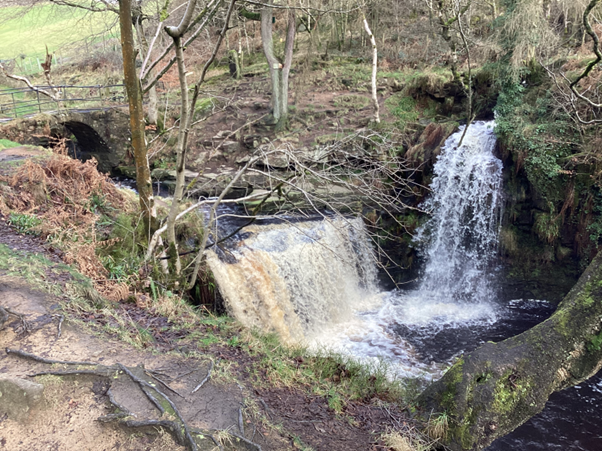
The other side of the clough is just as steep, but unpaved. Three ruined farmhouses pace the ascent: Sunny Bank; Nook, a laithe house with gaunt mullions; and Coppy, where the last electricity pole is well staked, but the people have blown away. The moor starts instantly the other side of the gate, and there is a desire path through young heather and grouse shit to the knoll.
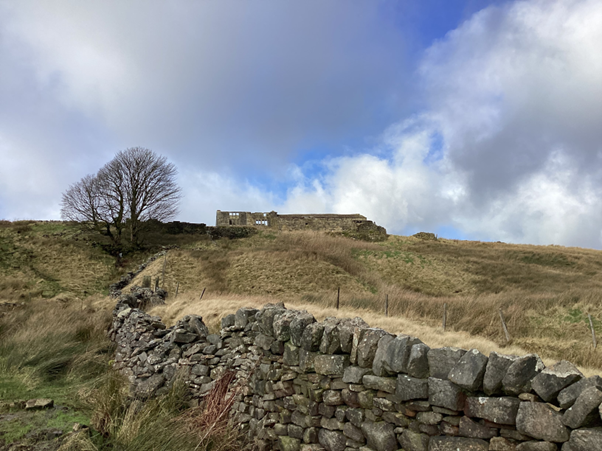
Somebody more imaginative than Mr Bannister has built an excellent cairn here. (It had blown down by my next visit, as had our garden wall, the only night I have been afraid in our house, and not during a ‘named storm’ either.) A 1604 survey of the Savile estate lists twenty-six farmsteads in Wadsworth, fourteen of them tenanted by Shackletons. The Todmorden & District News of February 1910 observes that “Residents of Hebden Bridge show great determination and grit, and a better exemplification of it could not be found than in the person of Sir Ernest Shackleton, who is descended from a family at Shackleton Hill on the Wadsworth side.” It is steep out of Crimsworth Dean, but not as sustained as Shackleton’s epic crossing of South Georgia.
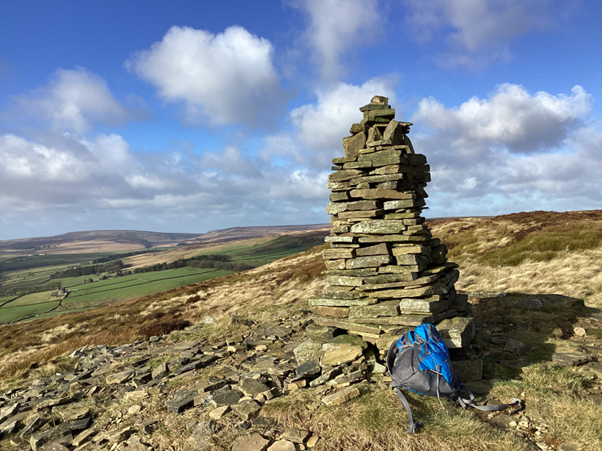
About fifty metres further up is the site of T6, visited in Richard Lilley’s blog. There is a pipe marking a water feature out of Alan Titchmarsh’s Garden Nightmares. It is a grouse bath, a pvc version of the smooth basins carved into Stanage Edge.
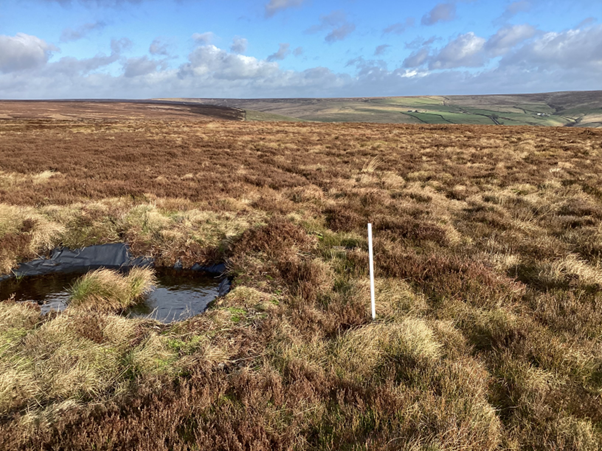
I greet the pipe with joy. My Silva compass has a bubble in it, and if Dastardly Dick Bannister’s consultant Muttley has put a pipe at all the turbine sites, I can skip taking dubious back-bearings on the Cock Hill mast. Looking to T25, T29 and T32 there is indeed a line of pipes on a neatly shaved strip of heather, as though Sean Connery had been prepped for a vasectomy. Sadly, although there seems to be a pipe at each turbine, there are also pipes not at turbines, so I twiddle the Silva disconsolately, trying to get the needle to stay north while the bubble effortlessly defeats the Earth’s magnetic field. The turbines’ positions are only virtual, given to one-metre precision in the developer’s reply to the MOD. Maybe Muttley let his fingers do the walking when he laid out CWF, using the laminated OL21 map that is so discreet about his employer’s activities.
Sylvia Plath might have rived up these pipes, as she did the snares that feature in her staggering poem ‘The Rabbit Catcher’. I know it by heart (“It was a place of force/ The wind gagging my mouth with my own blown hair”) and shout the final stanza to the moor and Muttley.
“And we, too, had a relationship/ Tight wires between us,/ Pegs too deep to uproot, and a mind like a ring/ Sliding shut on some quick thing/ The constriction killing me also”.
The poem was in the Ariel typescript found in the gas-filled flat, and Ted … suppressed it for a while. I bought his Birthday Letters on the day of publication and there was his own ‘The Rabbit Catcher.’ Sylvia’s taut masterpiece imagines her antagonist’s hands round a white mug. Her husband’s baggy response ( a bit blowy… ) explains that his wife’s imaginary rabbit catcher’s imaginary white mug was in fact blue. Ted’s interventions as muse-coach-husband-editor-survivor only add lustre to some of the best words written in the twentieth century.
Frieda Hughes signed the letter to the TLS against CWF (organised by Lydia MacKinnon and Clare Shaw) joining Andrew Motion, who succeeded Ted to the Laureateship, and hundreds of others. The fascination of the Plath-Hughes corpus is grievous family history for Frieda, who was herself in the Ariel flat, behind a bedroom door her mother had sealed. In 2004 she published a restored edition of the typescript. it is the best way to revisit the poems. Her parents will always enchant an intact Walshaw Moor.
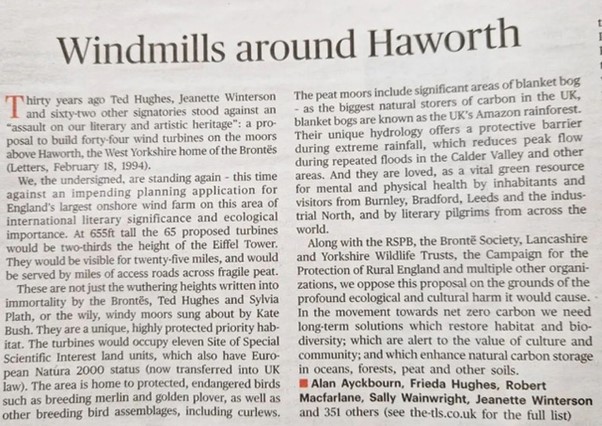
When I pull, the plastic pipe is not at all ‘too deep to uproot’. It slides gorgeously out and back into the peat with a contented sigh. I push it all the way in, trying to find pebbly boulder clay, but it is much more than two feet down here. I shall bring a six-foot bamboo cane next time but that may not be enough. Shackleton Moor is the squishiest Walshaw bog I have been on so far. The peat is like the finest underlay (‘Plushwalk 12: exceptional recovery and a sumptuous feeling underfoot’) and though my boots are soaked to the Gortex inner, the hems of my jeans are bone dry, so perfect is the saturated equilibrium. There is a myth put about by the developers that the peat on Walshaw Moor is degraded. It isn’t, but their wind farm will dry it out.

I squuuooge luxuriously to T32 on top of Round Hill, like Elizabeth Taylor sashaying up the carpeted stairs to receive her first Oscar from Yul Brynner. I’m less breathless at the top than the violet-eyed temptress was. Here too is a pipe, directing grouse to the medicated grit box after their spa day at T6, and a white stake which really is too deep to uproot. The shooting track across Wadsworth Moor from the Walshaw Dean reservoirs crosses the site. On my laminated OL21 (winner of the long-abandoned Oscar for Best Comedy Screenplay) this track ends at Calf Hey Clough, but in fact it continues around the CWF boundary, all the way to the Calder-Aire Link at Top of Stairs. The secret extension is surfaced with the slippery shale you might buy at the Gargrave garden centre to fake up an ishi-niwa in Coniston Cold. It would give a perfect base for cross-country skiing after the lightest snow fall. I look on to T34 on White Swamp, where ‘Mercator of the moors’ Christopher Goddard went on his blog trip. His yellow-paged guide to the moors sits broken-backed by the laptop for when I let my fingers do the walking. The second edition maps Mr Bannister’s contribution to Calderdale langlauf much more accurately than the OS.
Ernest Shackleton, whose prodigal ancestors did so much to thicken the Halifax phone book, was not a skier. Thomas Orde Lees showed him how effective they can be while both were marooned on Elephant Island. “After I had been back and forth four times, Shackleton said to me, ‘Do you know, I had no idea how quickly a man on ski could get about!’ ”
+++++++++++++++++++++++++++++++++++++++++++++++++++++++++++
Today, despite the brisk west wind
these turbines stand exhausted
as if they’ve praised and praised the Lord
waved and waved at passing planes
and still remain unrescued
CAROLA LUTHER
From On the Way to Jerusalem Farm, Carcanet Press, 2021
Carola Luther is published by Carcanet Press. She lives in Calderdale, and with Judith Willson, hosts the Dusty Miller Poetry Reading series in Mytholmroyd. She used to keep chickens, and now has a dog.
This is the 12th in a series of 65 guest blogs on each of the wind turbines which Richard Bannister plans to have erected on Walshaw Moor. Turbines 5, 6, 11, 27, 34, 35, 43, 47, 54, 58 and 64 have already been described. To see all the blogs – click here.
[registration_form]